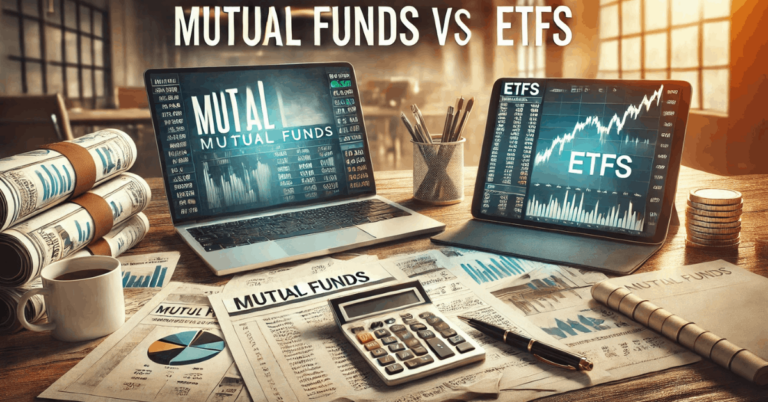Building a balanced portfolio is key to managing risk and maximizing returns in your investment strategy.
Diversifying through funds and ETFs allows you to spread your investments across various asset classes, reducing the impact of market fluctuations.
By carefully selecting the right mix, you can create a portfolio that aligns with your financial goals and risk tolerance.
Understanding a Balanced Portfolio
A balanced portfolio typically includes a mix of asset classes, such as stocks, bonds, and other investments, to ensure diversification.
The goal is to optimize returns while managing risk by balancing high-risk, high-reward assets with more stable, income-generating investments.
The Role of Funds and ETFs in a Balanced Portfolio
Funds and ETFs are vital for building a balanced portfolio by offering access to various asset classes and sectors.
They help diversify holdings, reduce risk, and manage portfolio volatility. Here’s how they contribute:
- Diversification – Funds and ETFs spread investments across multiple securities, reducing individual investment risk.
- Cost-Effectiveness – They usually have lower fees than managing individual stocks, making them affordable for investors.
- Liquidity – ETFs offer high liquidity, allowing easy buying and selling throughout the day.
- Accessibility – They provide direct access to markets and sectors that might be hard to invest directly.
- Professional Management – Experts actively manage funds, reducing the need for investors to make daily decisions.
Top Types of Funds & ETFs to Consider
When building a balanced portfolio, it’s essential to understand the various types of funds and ETFs available to suit different investment goals.
Here are the key categories to consider for optimal diversification:
Stock Funds & ETFs
- Equity funds and ETFs focus on stocks, offering growth potential.
- Recommended funds/ETFs: S&P 500 index funds for broad market exposure and tech-focused ETFs like the NASDAQ-100 for growth in the tech sector.
Bond Funds & ETFs
- Bond funds are vital for providing stability and income, balancing the riskier stock portion of your portfolio.
- Recommended bond funds/ETFs: U.S. Treasury bond funds for safety and corporate bond funds for higher yields.
International Funds & ETFs
- International funds/ETFs provide global exposure, helping to diversify beyond domestic markets.
- Recommended global funds/ETFs: MSCI World Index ETF for international exposure, emerging markets funds for growth in developing economies.
Sector & Thematic Funds/ETFs
- These funds allow investors to focus on specific industries or themes, such as healthcare, energy, or technology.
- Recommended sector-specific funds/ETFs: Healthcare ETFs for medical exposure, energy ETFs for renewable and traditional energy.
Real Estate Funds & ETFs
- Real estate funds and ETFs offer a way to invest in property markets through REITs or real estate-focused ETFs.
- Recommended real estate funds/ETFs: REIT ETFs for diversified property exposure and specialized ETFs for commercial or residential sectors.
Choosing the Right Funds & ETFs
Selecting the right funds and ETFs is crucial for building a portfolio that matches your financial goals and risk tolerance.
Here are the key factors to consider when choosing the right investments:
- Investment Goals: Decide if you want growth, income, or stability, and choose funds/ETFs that match your goals.
- Risk Tolerance: Assess your comfort with market fluctuations and select funds/ETFs that fit your risk level.
- Fees and Expenses: Compare expense ratios and management fees to ensure low costs for better returns.
- Performance History: Check historical performance, but remember past results don’t guarantee future returns.
- Asset Allocation: Ensure the funds/ETFs provide appropriate diversification across asset classes.
- Fund Management: Research the management team’s experience with actively managed funds.
Risk Management and Rebalancing
Periodically reviewing and rebalancing your portfolio ensures it stays aligned with your goals and risk tolerance while adapting to market changes.
Strategies for Managing Risk in a Balanced Portfolio
Managing risk is essential to protect your investments and achieve steady growth in a balanced portfolio.
Here are key strategies to effectively manage risk:
- Diversification: Spread investments across asset classes, sectors, and geographies to reduce reliance on any single asset.
- Asset Allocation: Allocate assets based on risk tolerance, dividing investments between stocks, bonds, and other classes.
- Regular Rebalancing: Adjust your portfolio to maintain the desired asset allocation and risk level.
- Quality Investments: Focus on high-quality assets with a proven track record to minimize the risk of underperformance.
- Emergency Fund: Maintain a cash reserve to handle unforeseen expenses without disrupting your investments.
- Risk Assessment Tools: Use tools and metrics like beta and standard deviation to measure and manage the risk of individual assets.
Understanding Fund Fees and Expenses
Understanding fund and ETF costs is essential, as fees can impact long-term returns.
Here are the main costs to consider:
- Expense Ratios: A small percentage of assets used for operations, typically 0.03% to 1%. Lower ratios keep more money invested.
- Management Fees: Fees for active management are usually higher than passive funds or ETFs.
- Trading Costs: Includes brokerage fees and bid-ask spreads for ETFs. Frequent trading increases these costs.
- Sales Loads: Some mutual funds charge upfront or exit fees. Choose no-load funds to avoid these.
- Administrative Fees: Small fees for account maintenance or reporting can add up over time.
5 Ways to Cut Costs and Boost Returns with Low-Cost Funds
Choosing low-cost funds is a simple way to reduce expenses and boost investment returns.
Here are five effective strategies:
- Choose Index Funds and ETFs: These typically have lower expense ratios than actively managed funds.
- Avoid Funds with Sales Loads: Opt for no-load funds to eliminate upfront or exit fees.
- Compare Expense Ratios: Select funds with the lowest expense ratios in their category.
- Limit Trading: Reduce trading frequency to avoid excessive brokerage fees and bid-ask spreads.
- Monitor Hidden Fees: Check for administrative or additional fees that may erode returns.
Building a Portfolio for Different Life Stages
Your investment strategy should adapt to your life stage, reflecting changing goals and risk levels.
Here’s how to tailor your portfolio:
- Early Career (20s-30s): Focus on growth with a high stock allocation. Use long-term compounding and higher risk tolerance to your advantage.
- Mid-Career (40s-50s): Add bonds and income funds to balance growth and reduce risk as retirement nears.
- Pre-Retirement (60s): Shift to stability with more bonds, dividend funds, and cash. Protect wealth while maintaining some growth.
- Retirement (70s and Beyond): Prioritize income and safety with low-risk bond funds and conservative ETFs to support withdrawals.
- Adjusting for Life Events: Reassess during significant life changes, like marriage or children, to align with new goals.
Monitoring Portfolio Performance
Regularly monitoring your portfolio ensures it stays aligned with your goals and adapts to market changes.
Here are key steps for effective portfolio tracking:
- Set Benchmarks: Compare your portfolio’s performance to relevant benchmarks like the S&P 500 or bond indexes to assess its progress.
- Track Asset Allocation: Review the allocation of stocks, bonds, and other assets to ensure they match your investment plan.
- Evaluate Fund Performance: Check the performance of individual funds or ETFs against their category averages and long-term goals.
- Review Costs: Monitor expense ratios, management fees, and other costs to ensure they remain competitive and do not erode returns.
- Adjust for Life Changes: Reassess your portfolio if your financial goals, risk tolerance, or life circumstances change.
To Sum Up
Building a balanced portfolio with the right mix of funds and ETFs is key to achieving your financial goals while managing risk.
Regularly reviewing and rebalancing your investments ensures they stay aligned with your objectives and adapt to changing market conditions.
Start assessing your portfolio today, and take steps to create a strategy that secures your financial future.


